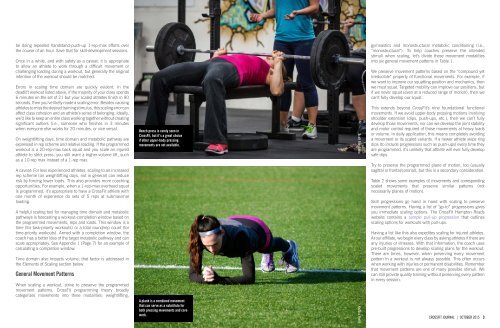SCALING CROSSFIT WORKOUTS
2mmo3pwZQ
2mmo3pwZQ
- No tags were found...
You also want an ePaper? Increase the reach of your titles
YUMPU automatically turns print PDFs into web optimized ePapers that Google loves.
e doing repeated handstand-push-up 1-rep-max efforts over<br />
the course of an hour. Save that for skill-development sessions.<br />
Once in a while, and with safety as a caveat, it is appropriate<br />
to allow an athlete to work through a difficult movement or<br />
challenging loading during a workout, but generally the original<br />
intention of the workout should be matched.<br />
Errors in scaling time domain are quickly evident. In the<br />
deadlift workout listed above, if the majority of your class spends<br />
6 minutes on the set of 21 but your scaled athletes finish in 90<br />
seconds, then you’ve likely made a scaling error. Besides causing<br />
athletes to miss the desired training stimulus, this scaling error can<br />
affect class cohesion and an athlete’s sense of belonging. Ideally,<br />
we’d like to keep an entire class working together without creating<br />
significant outliers (i.e., someone who finishes in 3 minutes<br />
when everyone else works for 20 minutes, or vice versa).<br />
On weightlifting days, time domain and metabolic pathway are<br />
expressed in rep scheme and relative loading. If the programmed<br />
workout is a 20-rep-max back squat and you scale an injured<br />
athlete to strict press, you still want a higher-volume lift, such<br />
as a 10-rep max instead of a 1-rep max.<br />
A caveat: For less experienced athletes, scaling to an increased<br />
rep scheme (on weightlifting days, not in general) can reduce<br />
risk by forcing lower loads. This also provides more coaching<br />
opportunities. For example, when a 1-rep-max overhead squat<br />
is programmed, it’s appropriate to have a CrossFit athlete with<br />
one month of experience do sets of 5 reps at submaximal<br />
loading.<br />
A helpful scaling tool for managing time domain and metabolic<br />
pathways is forecasting a workout-completion window based on<br />
the programmed movements, reps and loads. This window is a<br />
time (for task-priority workouts) or a total round/rep count (for<br />
time-priority workouts). Armed with a completion window, the<br />
coach has a better idea of the target metabolic pathway and can<br />
scale appropriately. See Appendix 1 (Page 7) for an example of<br />
calculating a completion window.<br />
Time domain also impacts volume; that factor is addressed in<br />
the Elements of Scaling section below.<br />
General Movement Patterns<br />
When scaling a workout, strive to preserve the programmed<br />
movement patterns. CrossFit programming theory broadly<br />
categorizes movements into three modalities: weightlifting,<br />
Bench press is rarely seen in<br />
CrossFit, but it’s a great choice<br />
if other upper-body pressing<br />
movements are not available.<br />
A plank is a combined movement<br />
that can serve as a substitute for<br />
both pressing movements and core<br />
work.<br />
Scott Brayshaw Kendra Prattt<br />
gymnastics and monostructural metabolic conditioning (i.e.,<br />
“monostructural”). To help coaches preserve the intended<br />
stimuli when scaling, let’s divide these movement modalities<br />
into six general movement patterns in Table 1.<br />
We preserve movement patterns based on the “compound yet<br />
irreducible” property of functional movements. For example, if<br />
we want to improve our squatting position and mechanics, then<br />
we must squat. Targeted mobility can improve our positions, but<br />
if we never squat (even at a reduced range of motion), then we<br />
can’t fully develop our squat.<br />
This extends beyond CrossFit’s nine foundational functional<br />
movements. If we avoid upper-body pressing motions involving<br />
shoulder extension (dips, push-ups, etc.), then we can’t fully<br />
develop those movements, nor can we develop the joint stability<br />
and motor control required of those movements at heavy loads<br />
or volume. In daily application, this means completely avoiding<br />
a movement or its scaled variants. If a newer athlete skips ring<br />
dips (to include progressions such as push-ups) every time they<br />
are programmed, it’s unlikely that athlete will ever fully develop<br />
safe dips.<br />
Try to preserve the programmed plane of motion, too (usually<br />
sagittal or frontal/coronal), but this is a secondary consideration.<br />
Table 2 shows some examples of movements and corresponding<br />
scaled movements that preserve similar patterns (not<br />
necessarily planes of motion).<br />
Skill progressions go hand in hand with scaling to preserve<br />
movement patterns. Having a list of “go-to” progressions gives<br />
you immediate scaling options. The CrossFit Hampton Roads<br />
website contains a sample pull-up progression that outlines<br />
scaling options for workouts with pull-ups.<br />
Having a list like this also expedites scaling for injured athletes.<br />
At our affiliate, we begin every class by asking athletes if there are<br />
any injuries or illnesses. With that information, the coach uses<br />
pre-built progressions to develop scaling plans for the workout.<br />
There are times, however, when preserving every movement<br />
pattern in a workout is not always possible. This often occurs<br />
when working with injuries or permanent disabilities. Remember<br />
that movement patterns are one of many possible stimuli. We<br />
can still provide quality training without preserving every pattern<br />
in every session.<br />
<strong>CROSSFIT</strong> JOURNAL | OCTOBER 2015 3


